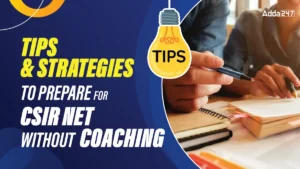Table of Contents
The University Grants Commission National Eligibility Test (UGC NET) will be held through offline mode on 18 June 2024. As NTA has changed the exam mode this year from online to offline mode, candidate must be desperate to know about the important instructions, strategies, and tips to Attempt the UGC NET Exam Offline. Here we are going to understand the approach for an offline pen and paper Exam mode and how can be beneficial offline mode for candidates.
Understanding the UGC NET Exam Structure
Before delving into the specifics of attempting the UGC NET offline, it’s essential to understand its structure. The UGC NET consists of two papers. the examination will be held through offline mode and Each question carries 2 marks, and there is no negative marking.
Paper I: General Paper on Teaching and Research Aptitude
- Duration: 1 hour
- Questions: 50 (all compulsory)
- Marks: 100
Paper II: Subject-specific Paper
- Duration: 2 hours
- Questions: 100 (all compulsory)
- Marks: 200
Preparation Tips for the UGC NET Offline Exam
Gather Necessary Materials
- Gather the Right Tools: Invest in good quality blue or black ballpoint pens, a pencil for rough work, and an eraser. Ensure comfort and minimize the risk of pen malfunctions.
- Practice with Mock Tests: Practice answering questions within the time limit using offline mock tests printed on paper. This simulates the actual exam experience and helps develop time management skills.
- Develop Offline Marking Techniques: Develop a clear system for marking answers on the OMR sheet. This could include circling chosen options or ticking boxes consistently.
Exam Day Strategy
- Admit Card and ID Proof: Carry your UGC NET admit card and a valid photo ID.
- Stationery: Pack pens, pencils, erasers, a sharpener, and any other allowed stationery.
- Tools: If required, bring a calculator, geometry set, or any other permitted tools.
- Water bottle: Staying hydrated is important, so carry a bottle of water.
- Dress Comfortably: Wear comfortable clothing suitable for the weather. Being physically comfortable can help maintain focus.
- Bring a Watch: A simple, non-digital watch can help you manage time without relying on the exam center’s clock.
- Stay Hydrated: Drink water during the exam to stay hydrated but avoid drinking too much to prevent frequent bathroom breaks.
Exam Centre Tips
- Check Your Seat: Once you arrive, verify your seat assignment and locate it promptly. This helps in starting the exam calmly without last-minute rushes.
- Avoid Last-Minute Cramming: Resist the urge to study right before the exam. This can cause unnecessary stress. Instead, try to relax and stay calm.
- Stay Calm and Positive: Engage in deep breathing exercises if you feel anxious. Positive affirmations can help maintain a positive mindset.
Dress Instructions for Candidates
Choose clothes that are comfortable and allow you to sit for extended periods without discomfort. Avoid tight or restrictive clothing that could distract you during the exam.
- Weather-Appropriate Attire: Light, breathable fabrics such as cotton are ideal.
- Adhere to Dress Code: If the exam center or the examination authority has a specific dress code, ensure you follow it strictly. Some exams have stringent dress codes to prevent cheating or for identification purposes.
- Religious Attire: If you wear specific clothing for religious reasons (e.g., hijab, turban), make sure it complies with the exam center’s guidelines. Most centers are accommodating but may ask for additional identification checks.
Tops
- Plain T-shirts or Shirts: Opt for plain, non-graphic T-shirts or shirts. Avoid flashy prints or logos that might be distracting.
- Collared Shirts: For a formal touch, collared shirts are a good option, especially if a formal dress code is required.
- Sweaters or Sweatshirts: If the weather is cool, a simple sweater or sweatshirt can keep you warm without being too bulky.
Bottoms
- Trousers or Jeans: Comfortable trousers or jeans are suitable. Ensure they are not too tight or too loose.
- Skirts or Dresses: For those who prefer skirts or dresses, ensure they are of an appropriate length and comfortable to sit in for long periods.
Footwear
- Closed Shoes: Comfortable closed shoes like sneakers or loafers are usually the best choice. They provide support and are suitable for most exam centers.
- Avoid High Heels: High heels can be uncomfortable and impractical for an exam setting.
- Socks: Wearing socks can help keep your feet comfortable and warm.
Accessories
- Minimal Jewelry: Keep jewelry to a minimum to avoid distractions or any issues with exam security.
- No Hats or Caps: Most exam centers do not allow hats or caps as they can be used to hide unauthorized materials.
- Watch: A simple, non-digital watch is useful for keeping track of time without relying on the exam center’s clock. Ensure it does not have any smart features.
Additional Items
- Glasses: If you need glasses for reading or seeing, ensure they are clean and comfortable.
- Hair Accessories: Use simple hair ties or clips to keep hair out of your face. Avoid large or distracting hair accessories.




 UPHESC Assistant Professor Question Pape...
UPHESC Assistant Professor Question Pape...
 Is the CSIR NET Exam Tough? Know the Dif...
Is the CSIR NET Exam Tough? Know the Dif...
 Tips & Strategies to Prepare for CSI...
Tips & Strategies to Prepare for CSI...














